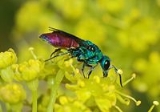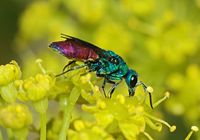
Cuckoo wasp
Encyclopedia

Hymenoptera
Hymenoptera is one of the largest orders of insects, comprising the sawflies, wasps, bees and ants. There are over 130,000 recognized species, with many more remaining to be described. The name refers to the heavy wings of the insects, and is derived from the Ancient Greek ὑμήν : membrane and...
n family Chrysididae is a very large cosmopolitan group (over 3000 described species) of parasitoid
Parasitoid
A parasitoid is an organism that spends a significant portion of its life history attached to or within a single host organism in a relationship that is in essence parasitic; unlike a true parasite, however, it ultimately sterilises or kills, and sometimes consumes, the host...
or cleptoparasitic wasps, often highly sculptured, with brilliantly colored metallic-like bodies (thus the common names jewel wasp, gold wasp, or emerald wasp are sometimes used). They are most diverse in desert regions of the world, as they are typically associated with solitary bee
Bee
Bees are flying insects closely related to wasps and ants, and are known for their role in pollination and for producing honey and beeswax. Bees are a monophyletic lineage within the superfamily Apoidea, presently classified by the unranked taxon name Anthophila...
and wasp
Wasp
The term wasp is typically defined as any insect of the order Hymenoptera and suborder Apocrita that is neither a bee nor an ant. Almost every pest insect species has at least one wasp species that preys upon it or parasitizes it, making wasps critically important in natural control of their...
species, which are also most diverse in such areas.
Members of the largest subfamily, Chrysidinae
Chrysidinae
The subfamily Chrysididae contains those species that are most commonly recognized as cuckoo wasps, being by far the largest and most familiar subfamily. The group contains some 3000 species in 48 genera in 4 tribes worldwide...
, are the most familiar; they are generally cleptoparasites, laying their eggs in host nests, where their larvae consume the host egg or larva while it is still young, then consuming the provisions. Chrysidines are distinguished from the members of other subfamilies in that most can curl into a defensive ball, in a process known as conglobation. This ability is shared with pill bugs, pill millipede
Pill millipede
Pill millipedes make up two orders of millipedes, often grouped together into a single superorder, Oniscomorpha. The name Oniscomorpha refers to the resemblance of pill millipedes to certain woodlice, namely the pillbugs of the family Armadillidiidae, also called "potato bugs", "doodlebugs", or...
s (which are often mistaken for pill bugs), and armadillo
Armadillo
Armadillos are New World placental mammals, known for having a leathery armor shell. Dasypodidae is the only surviving family in the order Cingulata, part of the superorder Xenarthra along with the anteaters and sloths. The word armadillo is Spanish for "little armored one"...
es. Members of the other subfamilies are parasitoid
Parasitoid
A parasitoid is an organism that spends a significant portion of its life history attached to or within a single host organism in a relationship that is in essence parasitic; unlike a true parasite, however, it ultimately sterilises or kills, and sometimes consumes, the host...
s, of either sawflies or walking stick
Phasmatodea
The Phasmatodea are an order of insects, whose members are variously known as stick insects , walking sticks or stick-bugs , phasmids, ghost insects and leaf insects...
s, and cannot fold up into a ball.
External links
- Chrysis. net a picture rich and very informative site
- Family Chrysididae - Cuckoo Wasps at Bugguide, images and information.
- Chrysididae Identification Guide An online guide to the Chrysidids of Eastern North America
- Hymis de Images (=Bilder)

